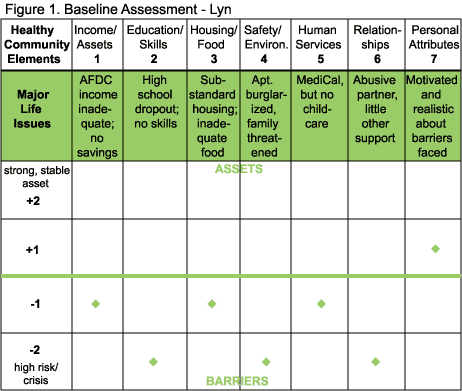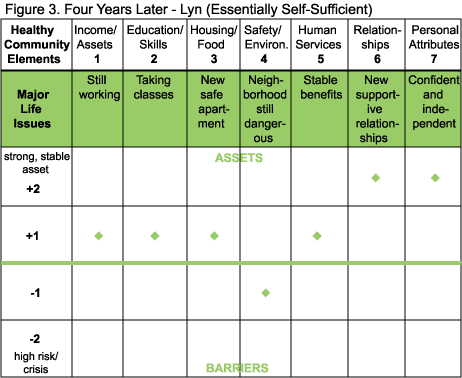The Harvard Family Research Project separated from the Harvard Graduate School of Education to become the Global Family Research Project as of January 1, 2017. It is no longer affiliated with Harvard University.
Volume lll, Number 1, 1997
Issue Topic: Methodology
Evaluations to Watch
Asian Neighborhood Design: A Practice-Based Anti-Poverty Analysis
Maurice Lim Miller, Executive Director of Asian Neighborhood Design, discusses an evaluation instrument for self-sufficiency that he developed and is using in San Francisco.
People living in poverty are generally thought of as being both economically and socially apart from the mainstream and requiring “special” assistance. The assistance has often taken the form of categorical services addressing the specific needs of targeted neighborhoods or populations, delivered through a variety of public, private, and community programs. While such an approach has led to the development of some excellent programs, their special focus and relatively short duration have often failed to account for the fact that the struggle out of poverty is more of a dynamic process than a static problem.
Stable self-sufficiency is another way to view the goal of attacking poverty. Stable self-sufficiency goes beyond the traditional notions of income level that have defined those in and out of poverty: Those who are self-sufficient exhibit a number of qualities, including the ability and resources to make choices based on plans for the future rather than immediate survival. While those struggling to achieve self-sufficiency must have access to service programs, these must be interconnected and combined with a supportive family or community environment. Thus, antipoverty work cannot be generic or categorical; rather, it is very personal and individualized.
For the past several years, Asian Neighborhood Design (AND) in San Francisco has developed and implemented an antipoverty strategy which focuses on individual strengths and weaknesses as a means to address the challenge of self-sufficiency. The foundation of this approach has been an evaluation instrument in which the client and the case worker work together to develop a “self sufficiency plan” for the client.
The self-sufficiency plan is based on an assessment of seven personal and environmental indicators: income/assets; education/skills; housing/food; safety/environment; human services; relationships; and personal attributes. Underlying this approach is the belief that each person's life is a combination of strengths (assets) and weaknesses (barriers) in these areas and it is the accumulation of a critical mass of strengths which is the distinguishing feature of those who are considered self-sufficient. While those who can be considered self-sufficient may still exhibit a number of weaknesses, the accumulation of strengths is enough to allow these individuals to function independently.
The instrument enables the case worker to get to know the participant in much the same way as one might know a relative or close neighbor. Through a self-assessment and interviews, a profile of the client, including his or her assets and barriers, is developed. The baseline assessment would be charted much as it is for a hypothetical client, Lyn, in Figure 1 (below). The methodology allows the client and the case worker to discuss the various interrelated issues that must be addressed in order for the client to achieve self-sufficiency.

This baseline assessment becomes the starting point for the case worker and the client to develop a personal self-sufficiency plan for the participant. This plan delineates what needs to be done to help the client to reach stable self-sufficiency. This is accomplished primarily through utilization of mainstream support systems or through special assistance based on the client's knowledge or initiative. Progress in achieving self-sufficiency is mapped on the chart at regular intervals. Figure 2 shows that after two years, Lyn has turned a number of barriers in her life into strengths.

Important, however, is the understanding that self-sufficiency is not achieved when one criterion is met. Rather, there are transitional phases. In the case of Lyn, although she has found a job and completed training, a number of factors in her life could still destabilize her. The program does not disengage from the individual until stable self-sufficiency is established.
In some cases, a client may take a number of years to develop and stabilize a critical mass of assets that will help him or her manage the risk factors that still affect his or her life. Figure 3 shows Lyn after 4 years. She has now secured a critical number of assets to help her to deal with the risk factors that continue to affect her life.

Unlike similar analytical instruments, the proposed methodology can be used to track progress of one individual or family over time. The method seeks to capture obvious difference in situations rather than nuances or gray areas. While not intended to be precise, the instrument breaks up overly complex life issues into seven basic elements.
AND's work with individuals and families to develop self-sufficiency plans is one aspect of its three-pronged, interactive approach to community building and empowerment. Another aim is to develop or enhance communities of people to support one another by establishing a tradition of peer assistance and responsibility and a sense of shared success. The program encourages the establishment of “career clubs” and a credit system as well as natural cultural or religious affiliations. At the same time, the program is working with policymakers, service providers, and funders by providing recommendations to make the “system” more compatible and responsive to the needs of the clients and their self-sufficiency plans.
Maurice Lim Miller
Executive Director
Asian Neighborhood Design
461 Bush Street, Suite 400
San Francisco, CA 94108
Tel: 415-982-2959

